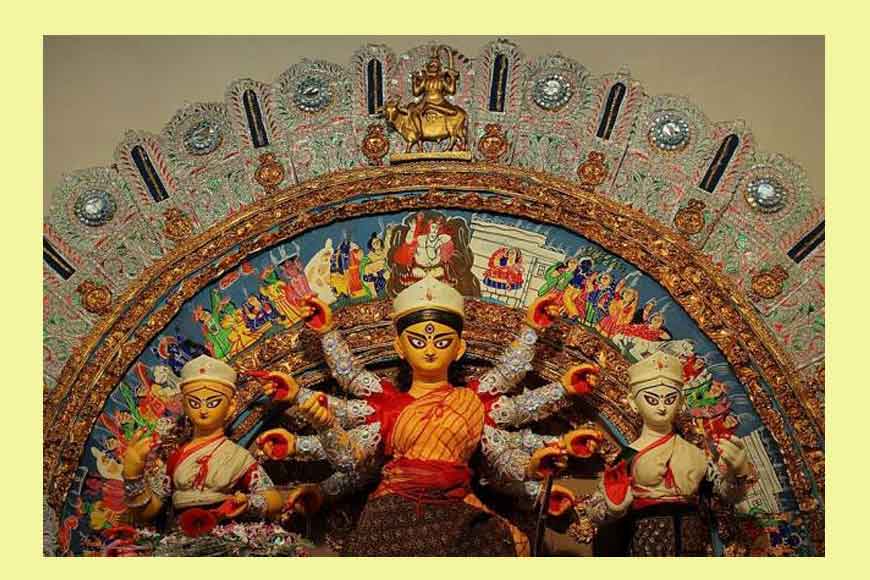A 500-year-old Durga Puja along the Shali River of Bankura

Far from the maddening crowds of Kolkata’s Puja revelers and dazzling pandals, lies Shyamdaspur, a tiny hamlet, tucked in Bankura’s hinterland. The Shali River flows gently by this idyllic village. Unending stretches of green fields sway in the gentle breeze and hurried barren feet of the villagers walk past the sauntering, bleating goats and cows as they trample the long, winding burnt-red soil path of the village. In the distance, Kaash flowers sway in unison and the early morning air fills with the pungent aroma of Shiuli flowers. Chhatim flowers bloom in abundance and it seems as if Mother Nature is heralding the onset of autumn and dressing up to usher in Goddess Durga for her annual visit to her parents’ home. This is also the time when the Mondal household turns into a flurry of activities as preparations for Durga Puja begins.
The Mondal Bari Puja at Shyamdaspur is significant in many aspects. For one, the Mondal family has been celebrating Durga Puja in their ancestral home here for more than 500 years now – it started much before the city of Kolkata originated! Dozens of beliefs, folklores, tradtions and rituals are weaved intrinsically with this Puja. Once a private family affair, over the centuries, it has attracted people from afar and now this annual event is attended by devotees and tourists from far off places.
Tracing the origin of the puja is also very interesting and it is steeped in both history and folklore. The puja was initiated about 500 years ago by Shyamdas Mondal, one of the ancestors of this family. He was a devotee of Goddess Durga and it earned him the nickname of Dugo. Once during Durga Puja, Shyamdas Mondal got a water-filled earthen pot from Shali River and placed it on a dias and began worshipping the pot as Goddess Durga. Later, he dreamt of Goddess Durga instructing him to formally institute an idol and commence with the Puja rituals annually. A Durga temple was built later to house the idol. With the passage of time, a temple dedicated to Lord Vishnu was also constructed. The village was christened later in the name of Shyamdas. Over time, the joint family disintegrated into fragments and moved to different corners of the country for livelihood but come Puja, and even now, they all reunite to their ancestral home in Shyamdaspur.
Every year, elaborate arrangements are made to worship the Goddess for six day. It begins on the auspicious day of Shasthi or the sixth day of the lunar cycle and continues till Ekadashi or the 11th day. Puja begins on Shashthi after the ritual of Bodhan (invocation). Kolparombho or Bodhan is the day Maa Durga reaches the mortal world from Kailash, her heavenly abode, with her children in tow — Lord Ganesh, Lord Karthik, Devi Saraswati and Devi Laxmi. After Bodhan, a palanquin is decorated and Nava-Patrika or Kola Bou is decked for the Kola Bou snan held on Mahashaptami, or the seventh day after Mahalaya. At the end of Maha Saptami puja, ash gourd is sacrificed on the alter and then the feasting begins. Every day, from Saptami afternoon till Eakadashi, more than 400 people partake a sumptuous bhog. This is part of the tradition the Mondals follow to this day. In the evenings, Arati is held . The next day, after Ashtami Puja, the Mondal family gets busy preparing for Sandhi Puja. All the family members bathe in the Mondal pukur (pond) and prepare the offerings to the Goddess. After the Sandhi Puja, a black male goat is sacrificed as part of the puja ritual.
On Navami, after the puja, an interesting ritual is followed. It’s called Narkel kara-kari (coconut snatching). All family members participate in this game. Whoever succeeds in snatching the coconuts is declared the winner. A maha-bhog is prepared with the mutton and distributed among all devotees.
On Dashami, a branch of the Aparajita (butter pea flower) is worshipped and then the Nava-Patrika and the earthen pots are carried in the palanquin for immersion. The immersion is followed by a sumptuous feast with fish caught from the Mondal pond. Ekadashi, the idol is taken around the village before it is immersed in Mondal pukur. This is followed by a community Khichuri bhog, and with this, the six-day-long festivities come to an end.










